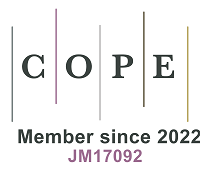REFERENCES
1. Roark A. M. Endocrine disruptors and marine systems. In: Goldstein, M. I.; DellaSala D. A, editors. Encyclopedia of the world’s biomes. Elsevier; 2020. pp. 188-94.
2. Chen, D.; Kannan, K.; Tan, H.; et al. Bisphenol analogues other than BPA: environmental occurrence, human exposure, and toxicity - a review. Environ. Sci. Technol. 2016, 50, 5438-5453.
3. Lehmler, H. J.; Liu, B.; Gadogbe, M.; Bao, W. Exposure to bisphenol A, bisphenol F, and bisphenol S in U.S. Adults and children: the national health and nutrition examination survey 2013-2014. ACS. Omega. 2018, 3, 6523-6532.
4. Vogel, S. A. The politics of plastics: the making and unmaking of bisphenol a “safety”. Am. J. Public. Health. 2009, 99. Suppl, S559-S566.
5. Rubin, B. S. Bisphenol A: an endocrine disruptor with widespread exposure and multiple effects. J. Steroid. Biochem. Mol. Biol. 2011, 127, 27-34.
6. Almeida, S.; Raposo, A.; Almeida‐gonzález, M.; Carrascosa, C. Bisphenol A: food exposure and impact on human health. Compr. Rev. Food. Sci. Food. Saf. 2018, 17, 1503-1517.
7. Hanaoka, T.; Kawamura, N.; Hara, K.; Tsugane, S. Urinary bisphenol A and plasma hormone concentrations in male workers exposed to bisphenol A diglycidyl ether and mixed organic solvents. Occup. Environ. Med. 2002, 59, 625-628.
8. Kang, J. H.; Kondo, F.; Katayama, Y. Human exposure to bisphenol A. Toxicology. 2006, 226, 79-89.
9. EFSA panel on food contact materials, enzymes, flavourings and processing aids (CEF). Scientific opinion on the risks to public health related to the presence of bisphenol A (BPA) in foodstuffs: opinion on BPA. EFSA. J. 2015, 13, 3978.
10. Rochester, J. R.; Bolden, A. L. Bisphenol S and F: a systematic review and comparison of the hormonal activity of bisphenol A substitutes. Environ. Health. Perspect. 2015, 123, 643-650.
11. Betancourt, A. M.; Eltoum, I. A.; Desmond, R. A.; Russo, J.; Lamartiniere, C. A. In Utero exposure to bisphenol a shifts the window of susceptibility for mammary carcinogenesis in the rat. Environ. Health. Perspect. 2010, 118, 1614-1619.
12. Ayyanan, A.; Laribi, O.; Schuepbach-mallepell, S.; et al. Perinatal exposure to bisphenol A increases adult mammary gland progesterone response and cell number. Mol. Endocrinol. 2011, 25, 1915-1923.
13. Kass, L.; Altamirano, G. A.; Bosquiazzo, V. L.; Luque, E. H.; Muñoz-de-toro, M. Perinatal exposure to xenoestrogens impairs mammary gland differentiation and modifies milk composition in Wistar rats. Reprod. Toxicol. 2012, 33, 390-400.
14. Zhang, K. S.; Chen, H. Q.; Chen, Y. S.; et al. Bisphenol A stimulates human lung cancer cell migration via upregulation of matrix metalloproteinases by GPER/EGFR/ERK1/2signal pathway. Biomed. Pharmacother. 2014, 68, 1037-1043.
15. Leung, Y. K.; Govindarajah, V.; Cheong, A.; et al. Gestational high-fat diet and bisphenol A exposure heightens mammary cancer risk. Endocr-Relat. Cancer. 2017, 365-378.
16. Tian, Y.; Baek, J.; Lee, S.; Jang, C. Prenatal and postnatal exposure to bisphenol a induces anxiolytic behaviors and cognitive deficits in mice. Synapse. 2010, 64, 432-439.
17. Melzer, D.; Rice, N. E.; Lewis, C.; Henley, W. E.; Galloway, T. S.; Zhang, B. Association of urinary bisphenol A concentration with heart disease: evidence from NHANES2003/06. PLoS. ONE. 2010, 5, e8673.
18. Ehrlich, S.; Williams, P. L.; Missmer, S. A.; et al. Urinary bisphenol A concentrations and early reproductive health outcomes among women undergoing IVF. Hum. Reprod. 2012, 27, 3583-3592.
19. Wang, H.; Li, Z.; Kang, L.; Li, X. Synthesis and field emission of β-SiC nanowires on silicon nanoporous pillar array. Appl. Surf. Sci. 2012, 259, 79-82.
20. Shankar, A.; Teppala, S.; Sabanayagam, C. Bisphenol A and peripheral arterial disease: results from the NHANES. Environ. Health. Perspect. 2012, 120, 1297-1300.
21. Wang, T.; Li, M.; Chen, B.; et al. Urinary bisphenol A (BPA) concentration associates with obesity and insulin resistance. J. Clin. Endocrinol. Metab. 2012, 97, E223-E227.
22. Caserta, D.; Bordi, G.; Ciardo, F.; et al. The influence of endocrine disruptors in a selected population of infertile women. Gynecol. Endocrinol. 2013, 29, 444-447.
23. Cantonwine, D.; Meeker, J. D.; Hu, H.; et al. Bisphenol A exposure in Mexico City and risk of prematurity: a pilot nested case control study. Environ. Health. 2010, 9, 62.
24. Shen, Y.; Zheng, Y.; Jiang, J.; et al. Higher urinary bisphenol A concentration is associated with unexplained recurrent miscarriage risk: evidence from a case-control study in Eastern China. PLoS. ONE. 2015, 10, e0127886.
25. Vahedi, M.; Saeedi, A.; Poorbaghi, S. L.; Sepehrimanesh, M.; Fattahi, M. Metabolic and endocrine effects of bisphenol A exposure in market seller women with polycystic ovary syndrome. Environ. Sci. Pollut. Res. Int. 2016, 23, 23546-23550.
26. Adoamnei, E.; Mendiola, J.; Vela-soria, F.; et al. Urinary bisphenol A concentrations are associated with reproductive parameters in young men. Environ. Res. 2018, 161, 122-128.
27. Wang, B.; Zhou, W.; Zhu, W.; et al. Associations of female exposure to bisphenol A with fecundability: evidence from a preconception cohort study. Environ. Int. 2018, 117, 139-145.
28. Den Hond, E.; Tournaye, H.; De Sutter, P.; et al. Human exposure to endocrine disrupting chemicals and fertility: a case-control study in male subfertility patients. Environ. Int. 2015, 84, 154-160.
29. Hart, R. J.; Doherty, D. A.; Keelan, J. A.; et al. The impact of antenatal Bisphenol A exposure on male reproductive function at 20-22 years of age. Reprod. Biomed. Online. 2018, 36, 340-347.
30. Radwan, M.; Wielgomas, B.; Dziewirska, E.; et al. Urinary bisphenol A levels and male fertility. Am. J. Mens. Health. 2018, 12, 2144-2151.
31. Tian, Y.; Zhou, X.; Miao, M.; et al. Association of bisphenol A exposure with LINE-1 Hydroxymethylation in human semen. Int. J. Environ. Res. Public. Health. 2018, 15, 1770.
32. Liao, C.; Liu, F.; Kannan, K. Bisphenol S, a new bisphenol analogue, in paper products and currency bills and its association with bisphenol A residues. Environ. Sci. Technol. 2012, 46, 6515-6522.
33. Liao, C.; Kannan, K. Concentrations and profiles of bisphenol A and other bisphenol analogues in foodstuffs from the United States and their implications for human exposure. J. Agric. Food. Chem. 2013, 61, 4655-4662.
34. Liao, C.; Kannan, K. A survey of alkylphenols, bisphenols, and triclosan in personal care products from China and the United States. Arch. Environ. Contam. Toxicol. 2014, 67, 50-59.
35. Okazaki, H.; Hirao-Suzuki, M.; Takeda, S.; et al. Bisphenol AF as an activator of human estrogen receptor β1(ERβ1) in breast cancer cell lines. J. Toxicol. Sci. 2018, 43, 321-327.
36. Zhao, Q.; Howard, E. W.; Parris, A. B.; et al. Bisphenol AF promotes estrogen receptor-positive breast cancer cell proliferation through amphiregulin-mediated crosstalk with receptor tyrosine kinase signaling. PLoS. ONE. 2019, 14, e0216469.
37. Catenza, C. J.; Farooq, A.; Shubear, N. S.; Donkor, K. K. A targeted review on fate, occurrence, risk and health implications of bisphenol analogues. Chemosphere. 2021, 268, 129273.
38. Sajiki, J. Determination of bisphenol A in blood using high-performance liquid chromatography-electrochemical detection with solid-phase extraction. J. Chromatogr. B. Biomed. Sci. App. 2001, 755, 9-15.
39. Schönfelder, G.; Wittfoht, W.; Hopp, H.; Talsness, C. E.; Paul, M.; Chahoud, I. Parent bisphenol A accumulation in the human maternal-fetal-placental unit. Environ. Health. Perspect. 2002, 110, A703-7.
40. Fukata, H.; Miyagawa, H.; Yamazaki, N.; Mori, C. Comparison of Elisa- and LC-MS-based methodologies for the exposure assessment of bisphenol A. Toxicol. Mech. Methods. 2008, 16, 427-430.
41. Teeguarden, J.; Hanson-drury, S.; Fisher, J. W.; Doerge, D. R. Are typical human serum BPA concentrations measurable and sufficient to be estrogenic in the general population? Food. Chem. Toxicol. 2013, 62, 949-963.
42. González, N.; Cunha, S. C.; Monteiro, C.; et al. Quantification of eight bisphenol analogues in blood and urine samples of workers in a hazardous waste incinerator. Environ. Res. 2019, 176, 108576.
43. Zhuang, W.; Wu, K.; Wang, Y.; et al. Association of serum bisphenol-a concentration and male reproductive function among exposed workers. Arch. Environ. Contam. Toxicol. 2014, 68, 38-45.
44. Nicolucci, C.; Errico, S.; Federico, A.; Dallio, M.; Loguercio, C.; Diano, N. Human exposure to bisphenol A and liver health status: quantification of urinary and circulating levels by LC-MS/MS. J. Pharm. Biomed. Anal. 2017, 140, 105-112.
45. Caporossi, L.; Paci, E.; Pigini, D.; et al. Urinary bisphenols as biomarkers of exposure to bisphenol A, bisphenol F, and bisphenol S: a new procedure for biomonitoring. Laboratories. 2025, 2, 7.
46. Matuszewski, B. K.; Constanzer, M. L.; Chavez-eng, C. M. Strategies for the assessment of matrix effect in quantitative bioanalytical methods based on HPLC-MS/MS. Anal. Chem. 2003, 75, 3019-3030.
47. Anderson, D. J.; Brozek, E. M.; Cox, K. J.; Porucznik, C. A.; Wilkins, D. G. Biomonitoring method for bisphenol A in human urine by ultra-high-performance liquid chromatography-tandem mass spectrometry. J. Chromatogr. B. Analyt. Technol. Biomed. Life. Sci. 2014, 953-954, 53-61.
48. Koch, H. M.; Kolossa-Gehring, M.; Schröter-Kermani, C.; Angerer, J.; Brüning, T. Bisphenol A in 24 h urine and plasma samples of the German Environmental Specimen Bank from 1995 to 2009: a retrospective exposure evaluation. J. Expo. Sci. Environ. Epidemiol. 2012, 22, 610-616.
49. Harrison, D. M.; Chang, W. C.; Lin, H. T. Using QuEChERS and HPLC Method to monitor the background concentration of polycyclic aromatic hydrocarbons in commercial black tea leaves and infusions in Taiwan. Toxics. 2024, 12, 148.
50. Ikezuki, Y.; Tsutsumi, O.; Takai, Y.; Kamei, Y.; Taketani, Y. Determination of bisphenol A concentrations in human biological fluids reveals significant early prenatal exposure. Hum. Reprod. 2002, 17, 2839-2841.
51. Völkel, W.; Colnot, T.; Csanády, G. A.; Filser, J. G.; Dekant, W. Metabolism and kinetics of bisphenol A in humans at low doses following oral administration. Chem. Res. Toxicol. 2002, 15, 1281-1287.
52. Dekant, W.; Völkel, W. Human exposure to bisphenol A by biomonitoring: methods, results and assessment of environmental exposures. Toxicol. Appl. Pharmacol. 2008, 228, 114-134.
53. Li, J.; Wu, C.; Zhao, H.; et al. Exposure assessment of bisphenols in Chinese women during pregnancy: a longitudinal study. Environ. Sci. Technol. 2019, 53, 7812-7820.
54. Zhang, H.; Li, J.; An, Y.; et al. Concentrations of bisphenols, benzophenone-type ultraviolet filters, triclosan, and triclocarban in the paired urine and blood samples from young adults: Partitioning between urine and blood. Chemosphere. 2022, 288, 132563.
55. Heffernan, A.; Baduel, C.; Toms, L.; et al. Use of pooled samples to assess human exposure to parabens, benzophenone-3 and triclosan in Queensland, Australia. Environ. Int. 2015, 85, 77-83.
56. Pia Dima, A.; De Santis, L.; Verlengia, C.; et al. Development and validation of a liquid chromatography-tandem mass spectrometry method for the simultaneous determination of phthalates and bisphenol a in serum, urine and follicular fluid. Clin. Mass. Spectrom. 2020, 18, 54-65.
57. Gu, J.; Yuan, T.; Ni, N.; et al. Urinary concentration of personal care products and polycystic ovary syndrome: a case-control study. Environ. Res. 2019, 168, 48-53.







